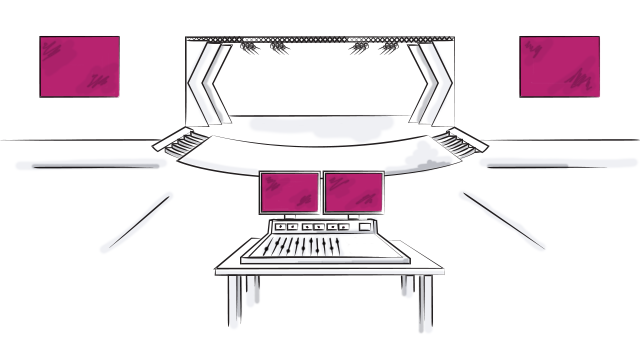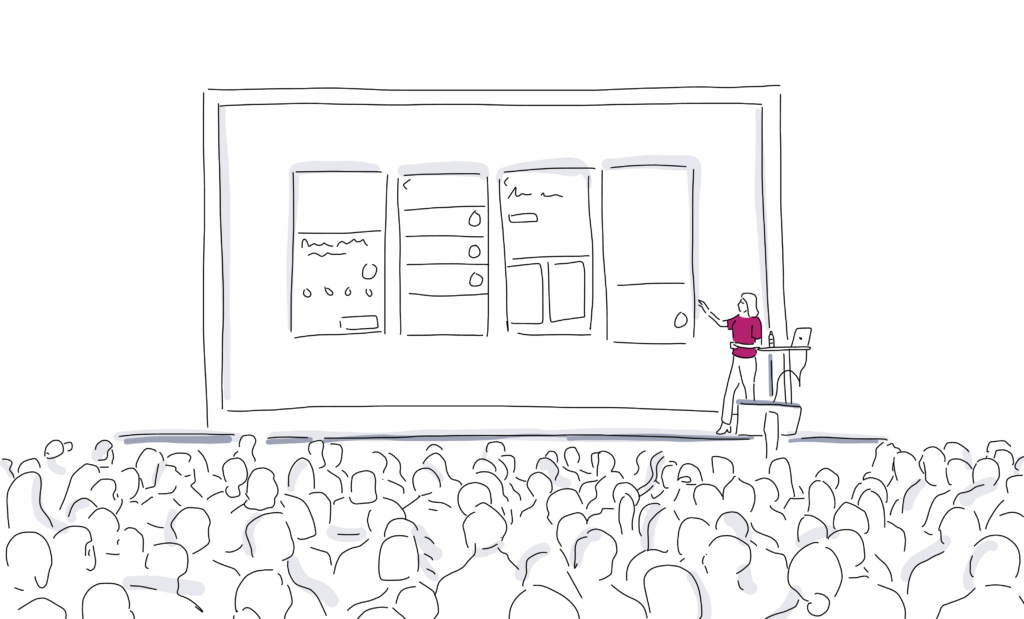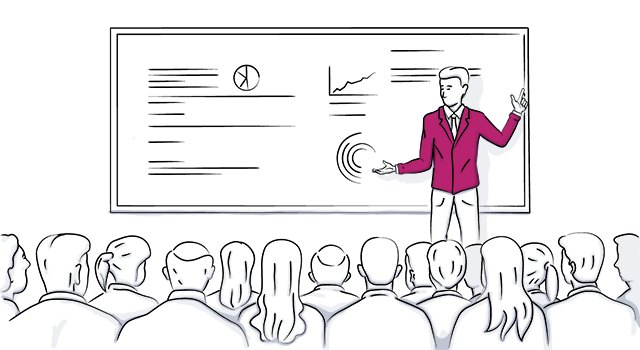
The Ultimate Audio Visual Checklist for Planners that Are Afraid of Technology
What’s on your event planning checklist for A/V at events? A/V is an essential at an event and, when done well, should appear seamless. Here is an event planning checklist for A/V that will ensure you deliver on your client’s event needs before the event even starts.
Use this simple audio visual checklist, to ensure that you’re communicating well and asking your a/v provider all the right questions. By the end of this post, not only will you understand how commonly used equipment works, you will be able to make sense of a quote and negotiate the best AV requirements for your function.
- Equipment Checklist for Events
- Steps to Customize Your Audio Visual Checklist for Your Event
- Layout Questions Event Planners Should Ask Their AV Company
Discover the Most Effective A/V Checklist for Events

1. Mixer / sound board for your event
Have more than one microphone in the same room? To balance the sound, control feedback, and adjust volume levels on microphones, your a/v team will be using a mixer or sound board. These electronic consoles manipulate and combine audio signals before routing them to your speakers. Be sure your A/V team knows exactly how many speakers will need microphones.
What if your event also requires additional microphones for audience questions? Then, make sure your mixer has enough channels.
Pro tip: To ensure presenters on stage will hear questions from the audience, you may want to consult your A/V technician about installing monitor speakers.
2. Aspect ratio for screens at the event
Aspect ratio refers to the ratio between the width and the height of a screen. The two most common ratios are 16:9, which are High Definition screens (also called widescreens) and 4:3, which are Standard Definition screens. This is usually a problem that planners run into when speakers create their own presentations. These days, widescreen is a more common standard. Make sure speakers are submitting slides that fit the 16:9 aspect ratio.
While your budget will dictate which screen you choose, remember to have your guest speakers format presentations accordingly.
3. Projectors for the event
The type of projector you select depends on your event. Are you showing PowerPoint presentations or videos? Will you need to stream a speech or interview?
For presentations, a brighter projector is generally better since it ensures good visibility. Always consider the amount of natural light, however. If a room has a lot of windows you will need an even brighter projector to ensure that everything is easily visible. As for streaming content, rear screen projection might be the solution for you since it provides better quality visuals.
4. Microphones for the event
Before selecting a microphone, ask yourself these questions.
- For what will the mic be used?
- Will it stay in one place?
If one speaker needs a mic and will stand in the same place, go wired. But, what if your speaker intends to take questions from the audience? A handheld wireless mic will ensure ease of movement. Consider using a CatchBox microphone to make Q&A even easier. It makes for a more interactive experience and easily integrates with most mixers.
Delivering a presentation and need your hands-free? Choose lavalier, a small microphone that easily clips on an earpiece or on clothing like a collar, tie or belt.
Last, a wireless microphone needs a transmitter to send audio signals through radio waves. For lavalier or headset microphones, a bodypack transmitter will do the trick – it can be mounted on clothing or fit inside a pocket.
5. Bandwidth to support devices at the event
Does your event have to support multiple devices like laptops, smartphones, and tablets? If you answered yes, then you may need more bandwidth.
That’s because bandwidth dictates how much information your internet connection can handle in a given period of time. Imagine water flowing through a pipe – too much water and the pipe could burst. So, what does this mean for you?
More bandwidth means more consistent upload and download speeds. It means uninterrupted streaming. And, most importantly, it will prevent the internet from crashing. Consider how many internet connected device we use every day. If your event has 100 attendees, but they’re each bringing a laptop, a smartphone ,and a tablet, you’ll need to allocate enough bandwidth for more than 300 devices.
6. Frequency band for your event
Simply put, a frequency band is a band of continuous frequencies that travels between two limits and transmits radio and television signals.
Every electronic device like wireless microphones, tablets, smartphones, laptops, and projectors emit signals at a particular frequency so make sure your microphone does not have to compete. Otherwise, you’ll hear screeching, which is fun for no one.
7. Transmitters and receivers for your event audio visual
Planning an event with live streaming? Or, need wireless microphones for your keynote speakers?
To avoid pesky wires in the middle of the floor, you will need a transmitter and receiver.These devices work in tandem and help transmit AV signals through radio waves to projectors and speakers across the room.
8. Adapters and dongles for event A/V
Are you speakers presenting from their own laptops? Do any of them need to be plugged into a projector? Then it’s a good idea to have several adapters on hand.
The simple reason is that most computers don’t HDMI outlets. HDMI is what allows you to connect your computer to your TV to watch things like Netflix, but they can also save your events from a potential A/V disaster.
[Tweet “Dongles connect computers and TVs to watch Netflix, but they can also save you from A/V disasters. “]
You don’t need to be as fluent as your technician but knowing how things work will improve your ability to identify your AV needs, and manage your budget.
Don’t forget, as Sasha Vasilyuk, co-founder of Sandbox Suites writes for Eventbrite, to test out equipment before your event as it’s the one thing that’s always prone to funkiness. Every event is different, which means each one has different AV requirements, so if you’ve worked with equipment not mentioned here, feel free to write about them in the comments.

If you found the information helpful, share it with your colleagues. Or join us on twitter @socialtables and share your A/V tips with us.
Here Are 7 Steps to Customize Your Audio Visual Checklist for Your Event
1. Find out your client’s basic A/V needs.
Picture this: it’s a typical day as an event planner. The phone rings and your client needs your planning expertise for their upcoming event. They quickly go through the basic information for an event that is six months away. Their agenda is rough, lacking important specifics like the number of presenters, and presenters’ A/V requirements. Their only event A/V requests are a screen, a projector, and sound including microphones. You start probing for more details.
2. Choose a screen type for presentations and video.
Once you have the basic format of the event figured out, you can choose a screen type. If you have a smaller general session space and audience size, one or two large flat screen monitors are a great option. In general, these types of screens are used for a more intimate setting, where the audience is close to the stage and presenter.
For a larger space and audience, screens and projectors may work better. This comes in handy especially if the presenter has a lot of data to share so people can read smaller fonts in the back row. Presentation screens are 4:3 format or 16:9 format (wide screen), so talk with your client to ensure presentations are designed in the same format as the projection screens.
When selecting projection screens take into consideration the aspect ratio. Presentation screens are 4:3 format or 16:9 format (wide screen), so talk with your client to ensure presentations are designed in the same format as the projection screens. Depending on the size of your space, you’ll need a projector that makes sense. You’ll need a projector with more lumens (brightness) if there are windows or lots of light in the room but your A/V provide should be able to recommend a projector for the job.
3. Ensure you have the audio essentials.
For house sound and external sound systems that are brought in, make sure there’s a decent size soundboard or mixer. Based on the needs of your client, your A/V provider can suggest a soundboard that can handle multiple microphone inputs and computer inputs. Plan on having video playback from a computer and include a Direct Box to help balance audio going to the soundboard/ mixer and prevent hum and buzzing.

Include a PA with enough speakers around the room, so that audio isn’t an issue. If you have music that is a key element of the program or performances on stage, you will need a more robust sound system.
Include a mix of wireless lavalier microphones, handheld microphones, and one hardwired microphone on a podium or stand on stage (in general, four to eight maximum). But don’t go crazy, too many microphones can be hard to manage.
If audio still has you stumped, hire an audio technician to manage the sound. It will save you a lot of headaches, and lessen the stress during the live event with an expert on-hand to help with issues.
[Tweet “Hiring an audio engineer can save you headaches, especially for events with music or live performances.”]
4. Consult with your A/V provider on the type of video switcher/ mixer.
A video switcher/ mixer is a must have if you have more than one computer to share on the screen, or if you are incorporating camera video of presenters on the screen. In this case, you will need a seamless video switcher.
If you have a simpler show with just a presentation and a few videos, you could use a crunch box. Crunch boxes are less complex video switchers that are perfect for basic presentations. As an event planner, you know the importance of having a Plan B. Think of the video switcher/ mixer as the Plan B. If one computer freezes, you can quickly switch to the backup computer with the click of a button.

5. Put your presenter at ease with the right technology.
Putting your presenter (and your client’s mind) at ease may just come with arming them with the right technology. Equip them with a confidence monitor, which allows the presenter to see their content without turning their back to the screen. It’s a simple solution for your presenter so he or she can engage the audience. Don’t forget a remote clicker with a laser pointer so you can give the presenters control of their content during the event.

6. Light up the stage.
Another item on your event planning checklist for A/V should be event lighting. Most venues have basic stage wash lighting so the presenters can be seen well. If you’re looking to add an extra touch of drama, you can achieve this with stage lighting. Additional lighting can add an inspiring, dynamic look to your overall event design and create an additional opportunity for branding with gobos.
7. Hire an event producer.
The checklist above covers most of the basics for general sessions. As your event evolves, there may be other requests such as video recording, webcasting, or bringing in remote presenters via video or a conference call.
For more complex shows, hiring an event producer is one of the best decisions you can make for your program’s execution and for your budget. The producer is a key partner who understands the content, the audience, the technology, and the budget. If you’re looking to knock your event out of the park for your client and attendees, an event producer might be a good fit to help you reach event success.
Up Next, See 5 Layout Questions Event Planners Should Ask Their AV Company for Accurate Setup
Here are a few of the right questions to make sure you’re aligned with your A/V partner to create a successful event.
1. Where is “front of house”?
Front Of House is defined as the location (sometimes it’s placed on a small stage riser) where the audio, lighting and sometimes video technician have their controls for the event. The best location for this is a place where the technical team can have an optimal view of the entire stage and all of the various elements they are controlling. While each has its advantages and disadvantages, common locations are in the center rear of the room, the center of the room (in the middle of all of the seating/standing), and the middle (not the rear and not the front) but off to either the left or right side. On occasion, your technicians may also place themselves behind the stage.
The reason this question is important is because depending on the amount of AV you have at your event, this may take up significant portion of your footprint. Also depending on what you are looking to accomplish for your event, the location that the AV team has in mind for your event may not work with what you are looking to do. Also, if the AV team is planning on being backstage, and you want them in the rear of the room. There may be added costs by adding more additional cabling such as an audio snake (a simple way of moving lots of cables with one single cable) or a switch to wireless (in the case of lighting primarily). If it works for your event, we recommend putting the front of house off to either side but in the middle of the room because this allows the technicians to see what the audience sees however, doesn’t sacrifice anyone’s view.
If your event does not have lighting, it is very common to see that your AV team requests to be behind the stage because they do not need a front of house. With the advancement of technology, many audio boards can be controlled by an iPad in the hand of a roaming technician, and video can be hidden behind the stage by using preview monitors.
[Tweet “Make AV easy by knowing which questions to ask your AV company”]
2. Where are you getting power from?
Often times, when we use a room layout maker we don’t think about where power (electricity) is coming from for their event (to be honest a planner shouldn’t have to) but often the AV company might forget about this minor, yet critical, detail until the very last minute. The reason it is important to ask this question is because you may have power needs as well and it’s important to collaborate to see where each of you is going to get that from. Also it’s very important because when working with an event that has substantial power needs, you need to mark on your layout where a power drop (large boxes which are used to convert power) might be placed. If the AV team needs the power placed on stage left, and it was placed on stage right, it might force them to rerun all of the cabling they had planned.

3. Where are the cables going to be run?
Unfortunately, the AV industry hasn’t gotten to the point where everything is wireless yet (we’re keeping our fingers crossed) and the industry standard for reliability reasons is that all of the various elements of an event must communicate using wired technology. It’s important to ask the AV company where it plans to run cables for a few reasons including: safety, aesthetics, and your personal preference. The movement of cables can severely impact the layout and what technologies are used.
The first being safety. The industry standard is that whenever a cable is ran across a walkway or a doorway that it will be taped down. However, some venues and planners require stricter cable management requirements. It is best to know this early on. The difference between taping a cable down and running it through an elaborate cable system can add hours of labor time and added costs to your final invoice.
Second being aesthetics. Some planners are very particular about seeing cables. For example, most AV companies consider backstage a sacred place where you can be a bit messier with your cables because only talent and the technicians will see the cables. However, if you’d like back of stage to look super tidy and clean, let your technicians know and they will take the extra effort to make it look clean. Also, some AV companies use cable ramps to cover cables however these tend to be bright yellow to avoid tripping. If you do not like the look of cable ramps, other options need to be discussed.
Last is personal preference. Everyone has their own personal preference when it comes to cables. For example, some planners do not want any cables running where people are walking, whether it’s protected by tape or cable ramp. This requires the AV team to rethink how it is going to run that cable then and may affect your layout. Another example, if you do not want cables running across a walkway, but there is no way to get the cable there, then you may have to rethink that walkway or if that piece of equipment needs to be placed there.
If you have to run cables over a long distance and you want to save aesthetics, and safety, AV companies can rig (hang) cables across the ceiling however, keep in mind that rigging costs (especially if you aren’t rigging already) may go up for this.
4. Are the projectors front projection or rear projection?
This may seem like a very simple question but it has a whole host of repercussions based on the decision of you and the AV company. This is one of those questions that you or your AV company should be asking and there are pros and cons to both. Your AV team should be able to do either rear or front projection and if you have a preference, let your AV team know.
If you are rear projecting, your projections will be placed behind stage. This is great if you are looking to safe footprint in front of the stage. It’s also great if you want to avoid when people walk in front of the screen and have a shadow cast on them. However, the downside is you need throw distance (the amount of distance needed to fill the entire screen) and if you don’t have enough room behind stage, then this might not be possible. However, be sure to ask if they have any short throw projectors available that need less distance to project though they might be more expensive.
Front projection is obviously the opposite of rear projection. If you front project, you have to keep in mind that you need to place the projector in front of the stage and that may be a location that a seat or table currently occupies. In your event layout, the AV company should place your projector and screen and calculate its exact location. There is a compromise to doing front projection but not taking up foot print, and that is to rig the projector to truss (metal systems used to hang lighting, video, etc) or to the ceiling. Keep in mind though, rigging is not possible in all venues, nor can it be cheap.
5. What is this all going to look like, really look like?
So your AV company has created this epic list of equipment and verbally explained that it’s everything you’re looking for, and you feel happy, but it feels like something is missing. Then the day of the event shows up, and it’s NOTHING like you expected. The screens are smaller than expected, the stage is too small, and there isn’t enough lighting!
There is a very simple way to avoid this from ever happening to you. Request a 3D design from your AV company. Most AV companies do not offer this because they take a long time to make, but if you request one, they should be willing to do one because it will make sure everyone is on the same page. A 3D diagram will allow the AV company to transform your list of equipment into a three-dimensional rendering of exactly what the stage, screens, lighting, video and everything will look like. Modern diagram softwares even let you see what it looks like with the lights in different colors and even do fly throughs of the event so you can see what it will be like to be there!
Quick Tip: While the first CAD design can be easy, try to get it perfect in as little amount of revisions as possible. Sometimes the first CAD may be free, however the 3rd or 4th revision may cost you money (especially if it’s a complete overhaul).
Now You’re Prepared with the Complete A/V Event Checklist!

Up next, discover what you need to know before you sign a hotel A/V contract, and try our easy event diagramming to ensure everyone is on the same page about the A/V experience.
Did we miss any items on our event planning checklist for A/V? Give us a holler on Twitter and let us know what you’d add to the checklist.
Still have questions about audio visual checklists for events?
Different events have different requirements, but there’s some equipment that comes in handy very frequently.
– Mixer / sound board
– Projectors
– Microphones, transmitters, and receivers
– Adapters and dongles to make sure everything can connect.
AV planning refers to planning and setting up the technology that will be used to display video or images and broadcast audio at an event.

